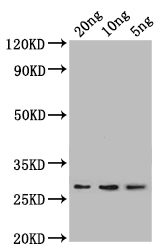To produce polyclonal antibodies against lpp, a rabbit undergoes repetitive immunizations with recombinant Escherichia coli (strain K12) lpp protein (21-78aa). Upon reaching an optimal antibody titer, the rabbit is bled, and antibodies are purified from the serum using affinity chromatography. The functionality of the resulting lpp antibody is subsequently evaluated through ELISA and WB applications, confirming its ability to interact specifically with Escherichia coli (strain K12) lpp protein.
The lpp protein in Escherichia coli (strain K12) is a crucial component of the bacterial cell envelope, playing a central role in maintaining structural integrity and stability. It contributes to cell adhesion, influencing initial biofilm formation and colonization of diverse environments. Additionally, lpp has been associated with modulating the host immune response, potentially impacting the pathogenicity of E. coli. It is implicated in antimicrobial resistance mechanisms, where changes in lpp can affect outer membrane permeability, influencing susceptibility to antibiotics.







